The Zimmermanns
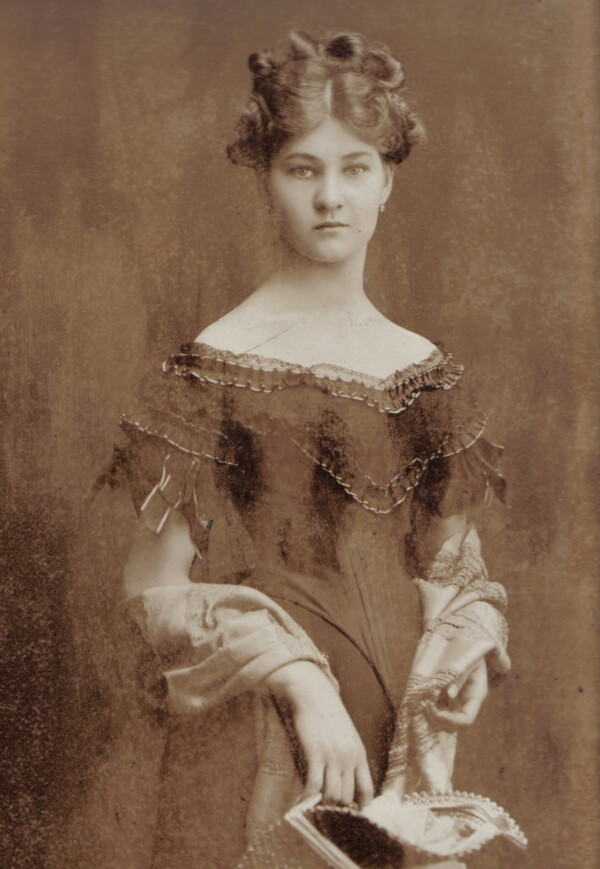
Maria Zimmermann, around 1898, private collection
© Bezirksmuseum Josefstadt, Wien
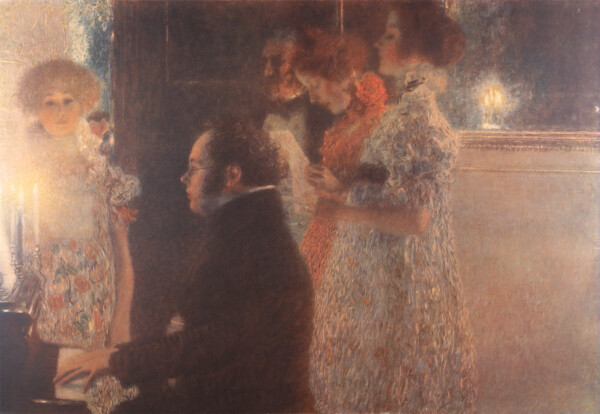
Gustav Klimt: Schubert at the Piano, 1899, 1945 in Schloss Immendorf verbrannt
© Klimt Foundation, Vienna

Gustav Klimt: Singing girls. Studies for the girl standing frontally and the girl on the right in the painting "Schubert at the Piano", circa 1896, Klimt Foundation
© Klimt Foundation, Vienna
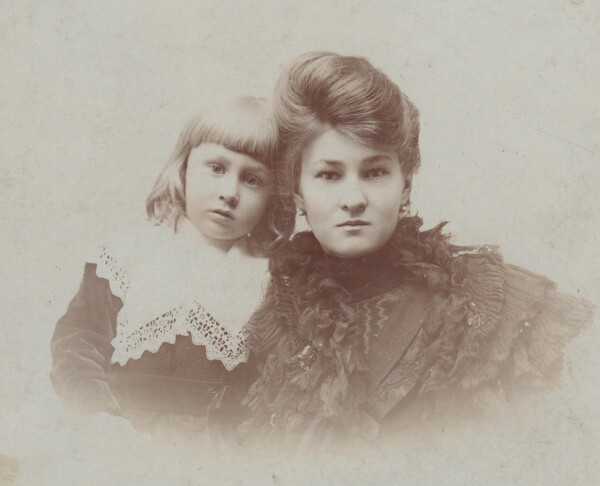
Maria Zimmermann with her son Gustav Zimmermann (detail) photographed by S. Fleck, around 1903, Klimt Foundation, Vienna
© Klimt Foundation, Vienna
Maria (Mizzi) Zimmermann was Gustav Klimt’s model. She became his lover and had two sons by the artist: Gustav in 1899 and Otto in 1902, who died aged only three months. The extensive correspondence between Klimt and Zimmermann provides insight into their relationship and also reveals many interesting details about the life and work of Gustav Klimt.
Maria Zimmermann (1879–1975)
Maria Leopoldine Katharina Zimmermann, called Mizzi or Marie, was born in Vienna on 14 May 1879 as the eldest daughter of Johann Zimmermann, who worked as an in-house carpenter for the Imperial-Royal Court and State Printing Office, and his wife Katharina. She was brought up in humble circumstances.
She presumably met Gustav Klimt around 1895; their earliest surviving correspondence dates from 1897. She posed for Klimt and became his lover. In the painting Schubert at the Piano (1899, destroyed by fire at Immendorf Caste in 1945), she posed for the figure in the background to the left. A comparison of the studies (1895/96, Moravská Gallery, S 1980: 3302; 1896, Österreichisches Theatermuseum, Vienna, S 1980: 3303; around 1896, Klimt Foundation, Vienna, S 1980: 3304), photographs of Maria Zimmermann and the final painting executed in 1899 reveals obvious similarities. There is no proof that she also posed for the pregnant nude in Hope I (1903/04, National Gallery of Canada, Ottawa); the features of the figure are not hers, at any rate. Hermann Bahr also mentioned her relationship with Klimt in his diary in 1930:
“And that painters sometimes make love to their models is said to happen anywhere every now and then […] He painted his girlfriend in the Schubert picture with sheet music in her hand, around that time, a son was born to him, who is now in his thirty-first year, followed by another boy four years later.”
When Klimt learned of Maria Zimmermann’s pregnancy, he wrote her a long letter in May 1899:
“Dear Miss Mizzi, I am so distressed I can hardly write. I am pondering in gloomy desperation. […] The unholy misdeed weighs heavily, heavily on me – how will it end? […] I have to provide for the growing life, for yourself for all future, I shall do it in the most fatherly way. You shall be looked after as if you were my wife.”
Their son Gustav was born on 1 September 1899, only two months after Klimt’s lover Maria Ucicka had also given birth to a son named Gustav. In his correspondence with Zimmermann, Klimt reported on his daily life and his health, his creative process and his works, his travels, his routine as well as his joys and worries concerning little Gustav. He also emphasized that during his summer vacation she should write to him only in an emergency, since the whole village would soon know who was writing to him. Like the other two mothers of his children – Maria Ucicka and Consuela Camilla Huber – she received financial support in the form of monthly payments, which were delivered personally, by mail or by messenger. Additionally, he paid for her apartment at Tigergasse 38, which was close to his studio at Josefstädter Straße 21 in Vienna’s 8th District, as well as for annual summer sojourns in Villach. Zimmermann’s letters to Klimt included annual birthday wishes on 14 July and name day greetings on 2 August, for which Klimt would usually thank her by including a small sum of money in his next letter.
On 22 June 1902, Maria Zimmermann gave birth to their second son Otto, who died after only three months. Klimt visited Maria and their son Gustav only occasionally and her wish to be married was never granted. Gustav Klimt’s surviving correspondence with Maria Zimmermann comprises many letters and cards dating from 1899 to 1903. For unknown reasons, they had a falling-out in late 1903, after which Klimt’s payments to Zimmermann were delivered solely via the lawyer and court advocate Dr. Julius Krickl.
After Klimt’s death in 1918, his son Gustav received a compensation and Maria worked as a seamstress and tram conductor. In 1931, she married the retired tram conductor Leopold Graindl, who died in 1937. Maria Zimmermann lived to the age of 95 and died in Vienna on 10 January 1975.
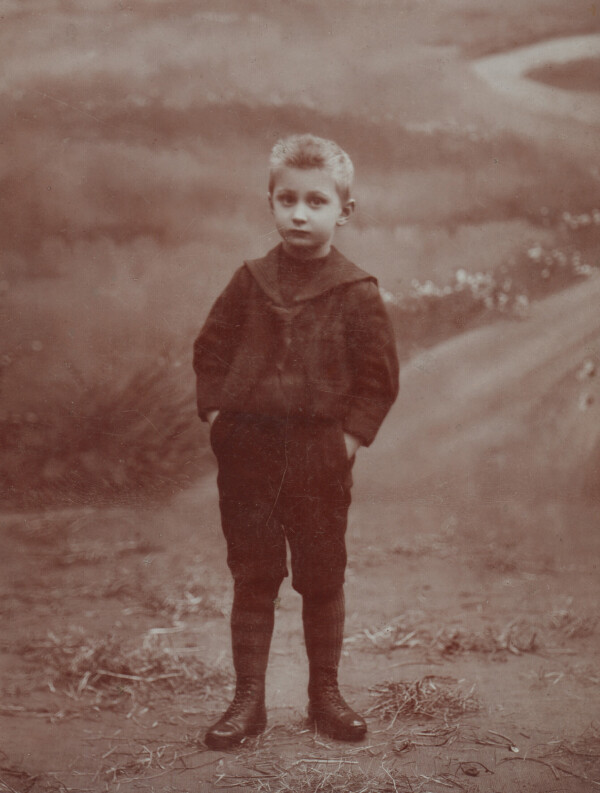
Gustav Zimmermann photographed by Ant. Duras, Klimt Foundation, Vienna
© Klimt Foundation, Vienna
Gustav Zimmermann (1899–1976)
Gustav Josef Max Zimmermann was born on 1 September 1899 to Gustav Klimt and Maria Zimmermann, only two months after Gustav Ucicky, the son of Klimt and Maria Ucicka. His godfather was Josef Ritter von Savinschegg, a royal-imperial steward, cavalry captain in the Landwehr, member of the regional parliament and owner of an estate in Krain (now Slovenia). It is not quite clear how he was connected to Zimmermann and Klimt. It seems that he was friends with Zimmermann for many years, they corresponded and met in Vienna and Villach and he also supported her financially.
Around 1902, Klimt painted his son on a square piece of cardboard, with the preliminary pencil drawing shining through the swiftly executed oil painting Portrait of Gustav Zimmermann (around 1902, privately owned). Klimt only rarely visited Marie Zimmermann and little “Gusterl,” but he regularly inquired after his son in quite loving terms. The boy even addressed a poem to his “dear Daddy” on 14 July 1912, presumably copied from a poetry album and signed “[…W]ith best wishes on your 50th birthday, yours, Gusti.”
According to family narratives, Gustav Zimmermann saw his father for the last time in 1917. After Gustav Klimt’s death in 1918, the lawyer and court advocate Dr. Otto Eckstein handled his estate and offered his son a sum of 4000 crowns. Following efforts to defend the claims of the minor – Klimt’s family and his three illegitimate children from his relationships with Maria Ucicka and Consuela Huber also had financial claims – a compensation of 5000 crowns was granted to Gustav Zimmermann on 19 December 1919.
Gustav Zimmermann married twice: He had three children with his first wife Johanna Blaschek and remarried in 1945. He died in Vienna on 8 April 1976.
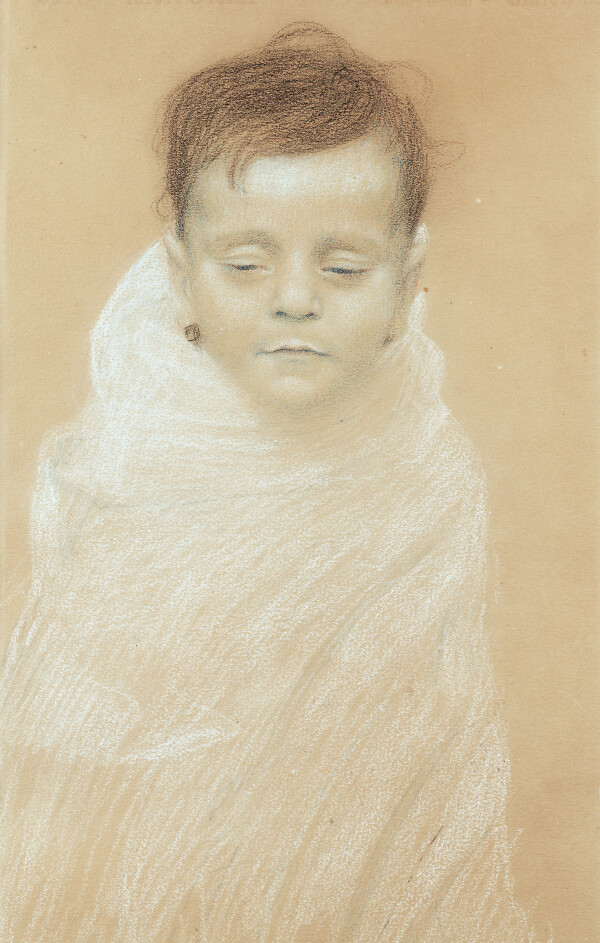
Gustav Klimt: Portrait of Otto Zimmermann, 1902, Leopold Privatsammlung: Portrait of Otto Zimmermann, 1902, Leopold Private Collection, Vienna
© Leopold Museum, Vienna
Otto Zimmermann (1902–1902)
The second son of Gustav Klimt and Maria Zimmermann was born in Vienna on 22 June 1902. Klimt reported to Maria’s mother Katharina:
“Dear Mrs. Zimmermann, A little boy arrived today at ¼ to 3 in the morning – unexpectedly – probably prompted by too brisk a movement. [The] birth was very painful – but a doctor who had been summoned as a precaution did not have to interfere. The midwife proved very helpful. Mother and son – and father are well.”
The son was christened Otto Josef Johann Gustav, his godfathers were Josef Ritter von Savinschegg – also the godfather of his elder brother Gustav – and his grandfather Johann Zimmermann. Otto died of a gastrointestinal catarrh only three months later on 11 September 1902 and Gustav Klimt created a deeply touching drawing (1902, privately owned, S 1980: 999) of his dead son. On the occasion of the death’s anniversary, he sent a letter to Katharina:
“Dear Mrs. Zimmermann, Attached I am sending 10 crowns, I am sending them to you at Mizzi’s request and hope you will forgive me for asking that the money be used to decorate ‘Otterl’s’ grave with flowers or a wreath, or both – it is the anniversary of his death – poor Otterl! I thank you in advance for your kindness. With warmest regards, yours, Gustav Klimt.”
Literature and sources
- Alice Strobl (Hg.): Gustav Klimt. Die Zeichnungen, Band IV, 1878–1918, Salzburg 1989, S. 54-57, S. 64-65.
- Sandra Tretter, Peter Weinhäupl (Hg.): Chiffre: Sehnsucht – 25. Gustav Klimts Korrespondenz an Maria Ucicka 1899–1916, Vienna 2014.
- Hansjörg Krug: Gustav Klimt selbstredend, in: Tobias G. Natter, Franz Smola, Peter Weinhäupl (Hg.): Klimt persönlich. Bilder – Briefe – Einblicke, Ausst.-Kat., Leopold Museum (Vienna), 24.02.2012–27.08.2012, Vienna 2012, S. 458-504.
- Brief von Gustav Klimt an Katharina Zimmermann sen. (Ende August 1903). S63/38.
- Brief von Gustav Klimt an Katharina Zimmermann sen. (23.06.1902). S63/36.
- Brief von Gustav Klimt in Wien an Maria Zimmermann (Mai 1899). S63/2.
- Brief von Otto Kiebacher in Wien an Maria Zimmermann in Wien (19.12.1919). S64/262.
- Brief von Julius Krickl in Wien an Maria Zimmermann in Wien (02.12.1909). S64/260.
- Brief von Julius Krickl in Wien an Maria Zimmermann in Wien (04.02.1915). S64/261.
- Brief von Otto Kiebacher in Wien an Maria Zimmermann in Wien (10/29/1919).
- Brief von Otto Kiebacher in Wien an Maria Zimmermann (06/04/1919).
- Bezirksmuseum Josefstadt (Hg.): Mizzi Zimmermann. Gustav Klimt und die Josefstadt, Ausst.-Kat., Josefstadt District Museum (Vienna), 02.10.2007–10.02.2008, Vienna 2007.
- Alfred Weidinger (Hg.): Gustav Klimt, Munich - Berlin - London - New York 2007, S. 274-275, Nr. 158.
- Hermann Bahr: Tagebuch. Von Hermann Bahr. 8. Dezember, in: Neues Wiener Journal, 28.12.1930, S. 14-15.

